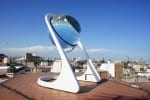 There are no shortage of companies and research organisations aiming to improve the sunlight-to-energy ratio of solar PV technology in cost-effective ways. Generating more electricity using the same amount of sun (and money) is something of a Holy Grail for the solar PV industry as a whole.
There are no shortage of companies and research organisations aiming to improve the sunlight-to-energy ratio of solar PV technology in cost-effective ways. Generating more electricity using the same amount of sun (and money) is something of a Holy Grail for the solar PV industry as a whole.
Approaches to accomplishing this goal vary widely. Better materials, components and manufacturing methods are some of the most common ways that companies improve efficiencies. Solar tracking systems are another economical and popular method for harnessing more energy with the same amount of PV material. Concentrated solar PV, though less common than flat panels, combines solar tracking with focusing technology that multiplies the sun’s power and therefore the amount of usable electricity output per square area unit of PV cell.
Once in a while, however, there are ‘outside the box’ approaches that are more radical in their basic approach to the problem and the technologies that they use. Now infamous Solyndra, for example, found a way to track the sun by revolutionising how solar panels are built. Their modules’ round PV tubes ensured that the sun’s rays would always strike their surface at close-to-ideal angles throughout the day without any need to adjust their orientation or tilt.
Other interesting approaches have included spinning solar tripods (which purportedly cool the solar cell as they rotate) and even ‘solar robots’ which perform tasks such as adjusting panel tilt & orientation to match the movement of the sun or working to keep panels clean.
One of the latest PV innovations to pop up is from a German Architect named André Broessel, whose idea earned him a finalist spot for a World Technology Network Award last year. Mr Broessel’s company, Rawlemon, is currently running a (apparently extremely successful) fundraising campaign on Indiegogo focusing on a smaller version of the device pictured above.
What Rawlemon offers is a kind of concentrating solar PV (CPV) device. Instead of using mirrors to reflect and focus sunlight on a photovoltaic cell or cells, however, the company’s ‘Solar Sphere’ takes advantage of the simple geometry and light-focusing properties of a glass globe. Rather than moving a heavy piece of equipment (such as an entire heliostat) to match a PV material’s movements to the sun’s for optimum yield, a much lighter kind of rounded arm containing PV cells revolves around a water-filled glass globe.
The sun’s rays are automatically captured and concentrated directly on the opposite side in line with the sun without complex or heavy tracking machinery. The sphere also promises to maximise power generation from the weaker, diffuse solar radiation available on cloudier days. Some are saying that the technology could even improve the yield of a solar cell by up to 35% compared to an similarly sized solar cell that doesn’t have the concentrator.
 Although it’s clear from the Indiegogo campaign that Rawlemon is seeking to commercialise the technology and disseminate it to the masses (initially in the form of a solar phone charger much smaller than the monument-style device pictured above), it is questionable whether the solar sphere solution is more economical and practical than a conventional, flat solar panel.
Although it’s clear from the Indiegogo campaign that Rawlemon is seeking to commercialise the technology and disseminate it to the masses (initially in the form of a solar phone charger much smaller than the monument-style device pictured above), it is questionable whether the solar sphere solution is more economical and practical than a conventional, flat solar panel.
First of all, the units are only more cost-effective if their total production cost is less than that of a conventional panel with the same rated power output–the devices may use a smaller area of PV cell, but overall they are likely to be both larger and heavier than a flat panel (good luck to anyone attempting to mount one on a roof).
On top of that is the possibility that the added heat that results from the increased concentration of sunlight could dampen the potential yield improvement. This is a hurdle that CPV technology developers have worked hard to overcome. As KCET’s Chris Clarke soberly pointed out, the solar sphere is ‘Nice, but no miracle’.
That being said, it’s hard to argue that there isn’t a great deal of appeal in the ‘cool factor’ of Rawlemon’s invention, and it’s not difficult to imagine a number of potential applications (BIPV among them). Given their stunning aesthetics, it would not be surprising to see the company’s solar spheres becoming common as decorative yet practical ornaments in yards, gardens, and other open spaces around the world.







